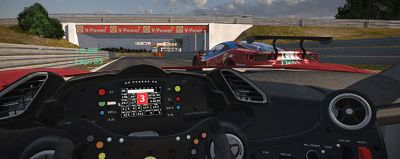-
United States -
United Kingdom -
India -
France -
Deutschland -
Italia -
日本 -
대한민국 -
中国 -
台灣
-
Ansys는 학생들에게 시뮬레이션 엔지니어링 소프트웨어를 무료로 제공함으로써 오늘날의 학생들의 성장을 지속적으로 지원하고 있습니다.
-
Ansys는 학생들에게 시뮬레이션 엔지니어링 소프트웨어를 무료로 제공함으로써 오늘날의 학생들의 성장을 지속적으로 지원하고 있습니다.
-
Ansys는 학생들에게 시뮬레이션 엔지니어링 소프트웨어를 무료로 제공함으로써 오늘날의 학생들의 성장을 지속적으로 지원하고 있습니다.
ANSYS BLOG
December 1, 2020
HUD Design: Keeping Your Head Up at 200 mph
For all the technology involved in Formula 1 racing, one aspect of the driving experience is old fashioned: Drivers still receive information about any obstacles ahead — like crashes, and how many seconds they trail the car in front of them — by radio from their team back in the control center. This valuable information is delayed by the time it takes to transmit and receive radio signals in a crowded radio airspace.
To speed up the relay of information, the Ferrari Competizioni GT team has been working with Ansys to develop a head-up display (HUD) for their Ferrari 488 GTE car. Like the HUDs used in some aircraft, important data is projected onto the windshield so the driver can view information like trailing time, warning signs and lap speed while looking straight ahead, so they don’t have to take their eyes off the road. When you are traveling more than 200 mph, eyes on the road are essential.
Ansys VRXPERIENCE was used to develop a HUD design for the Ferrari Competizioni GT team.
“Communication among engineers, drivers and the pit crew is critical in a race, so we want to explore the most efficient means of giving the driver all the information they need to win,” says Ferdinando Cannizzo, Head of GT Racing Car Design and Development. “A HUD is a promising, not only for speed of communication, but for added safety. Of course, to be safe the information displayed must be clearly visible without obstructing the course.”
HUD Design Technical Considerations
To test whether an automotive HUD would be valuable for a race car driver, Ferrari and Ansys engineers have been collaborating on simulations using Ansys VRXPERIENCE software to virtually test the critical parameters of such a system. The HUD must be clearly visible whether the sun is on the horizon and shining directly on the windshield or whether it is nighttime, which occurs in some races like the 24 Hours of Le Mans.
In addition, the amount of data displayed and its location on the windshield is an important variable. Too much information may overload the driver, whose attention must focus on the track and the surrounding race cars. Data projected onto the windshield must also be located in positions that the driver can see easily without blocking his view.
A final design point is where to locate the projector and any additional sensors that might be needed to collect data about the road ahead in an already crowded dashboard.
HUD Simulation Provides a Proof of Concept
Instead of trying to build a physical prototype of an automotive HUD system for a race car, engineers from Ferrari and Ansys used VRXPERIENCE to build a virtual driving simulator that could test the new components and their functionality.
The engineers simulated various light intensities from the projector combined with all angles of the sun — from the horizon to directly overhead — to determine the optimal projection brightness and to verify that projected data was visible no matter what the sun’s position in the sky. They also tested it in nighttime conditions to prove that it was not too distracting in dark driving conditions.
The Ansys VRXPERIENCE human-machine interface (HMI) enabled
Ferrari drivers to take a virtual test drive of the HUD design.
Once they were satisfied that the HUD could operate successfully in all racing situations, the engineers turned to VRXPERIENCE to create a human-machine interface (HMI) that Ferrari drivers could use to evaluate the experience of driving with a HUD. From initial trials using a virtual HUD, the drivers have given feedback about the types of information they need and how best to display it. They decided that speed, time behind the car in front, lap time and warning flags were the most critical data they needed to know.
“We have been considering adopting a HUD system for our race cars for a long time,” says Cannizzo. “But we were concerned about the amount of time and effort it would take to design and test such a system. Collaborating with Ansys engineers and using Ansys Speos and VRXPERIENCE minimized the time it took to prove the concept of using a HUD in race cars. Now we plan to continue using Ansys simulations as we further develop a working model for use on the track.”
The VRXPERIENCE HMI is also useful in determining where to place a button controlling the HUD projection of the dashboard, should a driver decide to turn it on or off. In a virtual reality environment, drivers can test the reachability of the button to determine its placement. The HMI can test and validate the HUD in realistic racing conditions by including the race track and other cars in the scenario.
Ultimately, a race car HUD design will be programmable to the needs of each particular driver: One may want more information on the HUD than another. In any case, being able to see critical data instantly rather than waiting for it to be reported to the team and then relayed to the driver by radio will be a great leap forward in racing technology.













